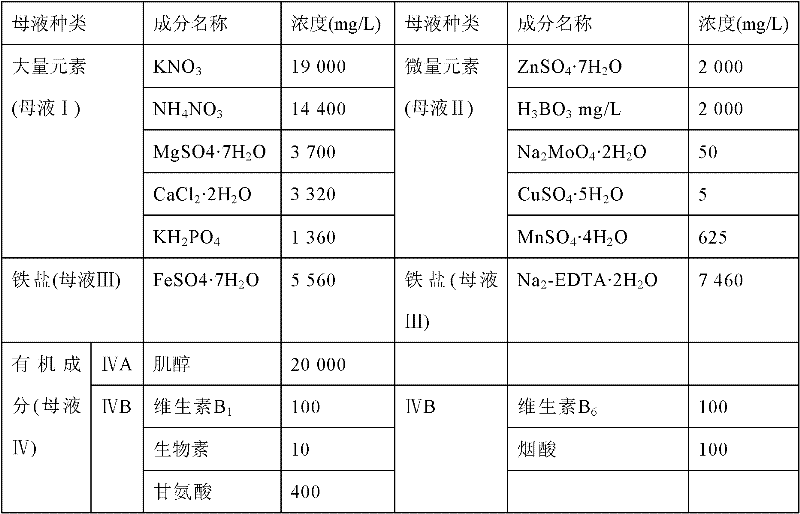Breeding method of poplar haploid
A cultivation method and haploid technology, applied in horticultural methods, botany equipment and methods, plant regeneration, etc., can solve the problems of low callus induction rate, low callus organ differentiation rate, etc., to achieve robust growth, The effect of high reproduction coefficient
- Summary
- Abstract
- Description
- Claims
- Application Information
AI Technical Summary
Problems solved by technology
Method used
Image
Examples
Embodiment 1
[0027] 1. Test materials
[0028] 1. Test material: Populus beijingensis;
[0029] 2. Plant growth regulator
[0030] The plant growth regulating substance used in the present invention adopts domestic naphthaleneacetic acid (NAA), 6-benzylaminoadenine (BAP), 6-furfurylaminopurine (KT), gibberellin (GA 3 ), 2,4-dichlorophenoxyacetic acid (2,4-D), indole butyric acid (IBA).
[0031] 3. Preparation of culture medium:
[0032] (1) Composition and preparation method of "MS basic medium":
[0033] Table 1 MS medium (Murashige and Skoog, 1962)
[0034]
[0035] The consumption of above-mentioned various nutrient components, except that mother liquor I is 20 times of concentrated solution, all the other are 200 times of concentrated solution. After the above MS medium mother solution was prepared, it was stored in a refrigerator at 4°C until use. According to the total amount of the prepared medium, weigh the required agar and sucrose, pour it into distilled water with 3 / 4 o...
Embodiment 2
[0049] 1. The appropriate development period of anthers and microspores cultured in vitro
[0050] Cut the poplar branches with full flower buds and culture them in water at room temperature 25°C for several days. Poplar flower buds were placed on glass slides, anthers were peeled off, stained with acetic acid carmine, and microspore development stages were observed under a microscope to determine the pollen development stages. In this experiment, the anthers whose microspores were at the uninucleated marginal stage were selected for inoculation, and the research results showed that this is the best time for anther culture.
[0051] 2. Disinfection of explants
[0052] Remove the flower buds that are in the single-nucleus marginal stage from the catkins, first use a brush to lightly brush the surface of the Beijing poplar flower bud scales, remove the dirt and bacteria on the surface, and improve the disinfection effect, and then rinse with sterile water for 5 times , filter...
Embodiment 3
[0095] 1. Preparation of sterile anthers
[0096] Take the poplar flower buds at the single-nucleus stage, rinse the flower buds with sterile water for 3-5 times, blot the water with filter paper, soak the flower buds with 70.0% alcohol by volume for 30 seconds, and then use 7.0% sodium hypochlorite The solution was sterilized for 5 minutes, and then the flower buds were washed 3-5 times with sterile water. Peel off the scales of the flower buds on an ultra-clean workbench, and take out the anthers in the middle of the inflorescence.
[0097] 2. Callus induction culture
[0098] The anthers were inoculated in the callus induction medium for dark culture, culture conditions: under dark conditions, the culture temperature was 25±1°C, cultured for 120 days, and the statistical anther callus induction rate was 30.0%. Among them, the callus The induction medium is: H+NAA 1.0mg / L+KT 1.0mg / L+sucrose 30g / L+agar 5.5g / L, pH5.5.
[0099] 3. Adventitious bud differentiation culture
...
PUM
 Login to View More
Login to View More Abstract
Description
Claims
Application Information
 Login to View More
Login to View More - Generate Ideas
- Intellectual Property
- Life Sciences
- Materials
- Tech Scout
- Unparalleled Data Quality
- Higher Quality Content
- 60% Fewer Hallucinations
Browse by: Latest US Patents, China's latest patents, Technical Efficacy Thesaurus, Application Domain, Technology Topic, Popular Technical Reports.
© 2025 PatSnap. All rights reserved.Legal|Privacy policy|Modern Slavery Act Transparency Statement|Sitemap|About US| Contact US: help@patsnap.com



